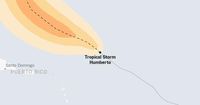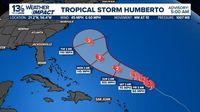As the 2025 Atlantic hurricane season enters its most volatile stretch, meteorologists and coastal communities alike are keeping a wary eye on a trio of storms churning across the ocean. According to FOX 35 Orlando and the National Hurricane Center (NHC), Hurricane Gabrielle, Tropical Storm Humberto, and the developing Invest 94L are all making headlines with their unpredictable paths and potential impacts.
Hurricane Gabrielle, a formidable Category 2 storm, is currently barreling eastward across the Atlantic at a brisk 32 mph. On Thursday, September 25, 2025, the hurricane was located about 655 miles west of the Azores, a remote volcanic archipelago roughly 850 miles off Portugal’s coast. With maximum sustained winds near 85 mph and higher gusts, Gabrielle is packing enough punch to warrant a Hurricane Warning for the Azores, forecasters at both the NHC and FOX Weather have confirmed.
Residents of the Azores are bracing for a rough ride. The NHC has warned that hurricane conditions—including torrential rain, powerful winds, and a dangerous storm surge—are expected to begin Thursday night and last into Friday morning. Coastal flooding and large, destructive waves are likely, especially as Gabrielle is forecast to bring up to 5 inches of rain across the central and western islands. "Swells generated by Gabrielle will continue to affect Bermuda, the U.S. East Coast from North Carolina northward, and Atlantic Canada over the next day or so," FOX 35 Storm Team Meteorologist Brooks Garner reported. Life-threatening surf and rip currents are a real concern for those in the path of the storm’s far-reaching influence.
The hurricane’s core is expected to pass directly over the Azores before weakening and transitioning into an extratropical low. Still, hurricane-force winds extend outward up to 60 miles from Gabrielle’s center, while tropical-storm-force winds reach as far as 195 miles, magnifying the zone of potential impact. The storm’s minimum central pressure sits at 979 mb, a testament to its current strength.
Meanwhile, Tropical Storm Humberto, which emerged from Invest 93L on Wednesday, September 24, is steadily strengthening in the Atlantic. As of 5 a.m. on Thursday, Humberto was located about 480 miles east-northeast of the Northern Leeward Islands, moving northwest at 10 mph. The NHC noted that Humberto’s maximum sustained winds are near 45 mph, with higher gusts, and the storm is expected to intensify over the next several days.
Though Humberto’s winds extend outward up to 105 miles from the center, forecasters are quick to reassure residents of Florida and the Southeastern U.S. that the storm poses no direct threat to their shores. Instead, Humberto is projected to curve eastward out into the open Atlantic. Still, the storm’s presence is expected to affect the eastern U.S. coast with winds up to 39 mph within five days, and its swells will contribute to rough surf and heightened rip current risks along the coast, as highlighted by NBC News.
But the Atlantic isn’t done yet. Invest 94L, a tropical wave currently near the Dominican Republic, is keeping meteorologists on their toes. The system is producing widespread, disorganized showers and thunderstorms as it moves west-northwest at 10–15 mph. Heavy rainfall and gusty winds are already spreading across Puerto Rico and the Dominican Republic, and the disturbance is expected to slow and turn northwestward near the southwestern Atlantic in the coming days.
According to the NHC, there’s a 50% chance that Invest 94L will develop into a tropical depression within 48 hours and a whopping 90% chance within the next week. Interests in Puerto Rico, the Dominican Republic, Haiti, the Turks and Caicos Islands, and the Bahamas are being urged to monitor the progress of this system closely. The potential for local impacts is significant: for residents near Daytona Beach, Florida, the forecast for Sunday and Monday (September 28-29) includes the possibility of a tropical system offshore, anywhere from 125 to 250 miles out. The closer the system tracks to the coast, the greater the impacts—gusty winds up to 40 mph, periods of heavy rain, dangerous breaking waves, and an extreme rip current risk are all on the table. Beach erosion during high tide is also a possibility, especially if the storm’s outer bands brush the shoreline.
It’s worth noting that, while the official peak of the 2025 Atlantic hurricane season was on September 10, the most active months historically are August, September, and October. The season itself runs from June through November 30, so there’s still plenty of time for more activity to develop. As FOX Weather points out, “We are on the clean side, so we’d be spared from the worst, but not completely from all impacts.”
Elsewhere, in the Pacific, Hurricane Narda is making its own waves—though, thankfully, not towards populated land. As reported by NBC News, Narda was about 580 miles south-southwest of the southern tip of Mexico’s Baja California peninsula late Wednesday, with top sustained winds of about 90 mph. The hurricane is moving west at 10 mph, and while it is expected to weaken over the next day or so, it could restrengthen on Thursday and Friday. No coastal watches or warnings are in effect for Narda, but swells generated by the storm could bring rough surf and rip current conditions to some parts of coastal Mexico.
With multiple systems swirling in both the Atlantic and Pacific, the 2025 hurricane season is living up to its reputation for unpredictability and danger. Meteorologists stress the importance of vigilance, especially for communities in the Azores, along the U.S. East Coast, and in the Caribbean. The message is clear: stay informed, heed local advisories, and be prepared for rapidly changing conditions.
This reporting is based on updates from the National Hurricane Center, FOX 35 Orlando, FOX Weather, and NBC News, all as of September 25, 2025. As the season continues, both experts and residents will be watching the tropics with bated breath, hoping for the best but preparing for whatever nature decides to send their way.
With the Atlantic alive with activity and the Pacific not far behind, the next chapter in this year’s hurricane saga is still being written—one forecast at a time.






